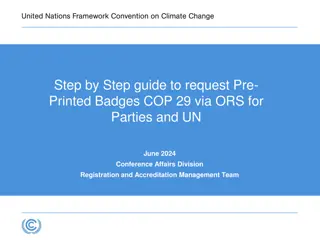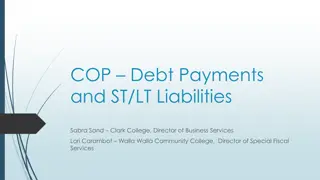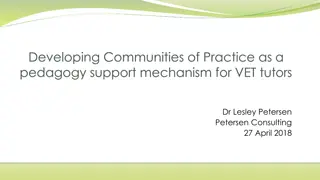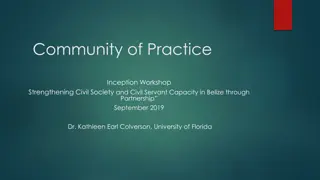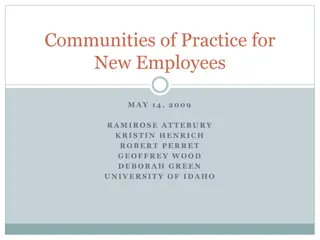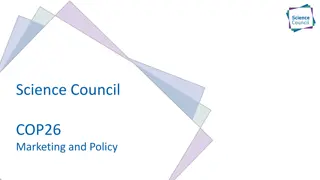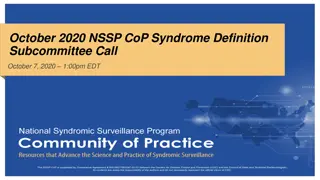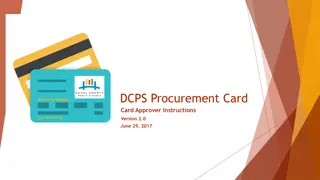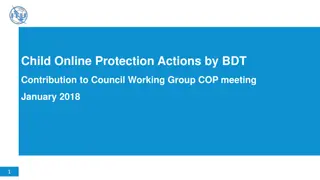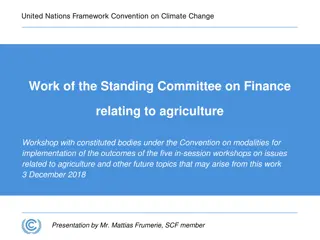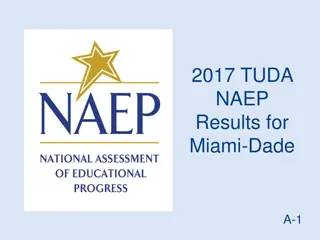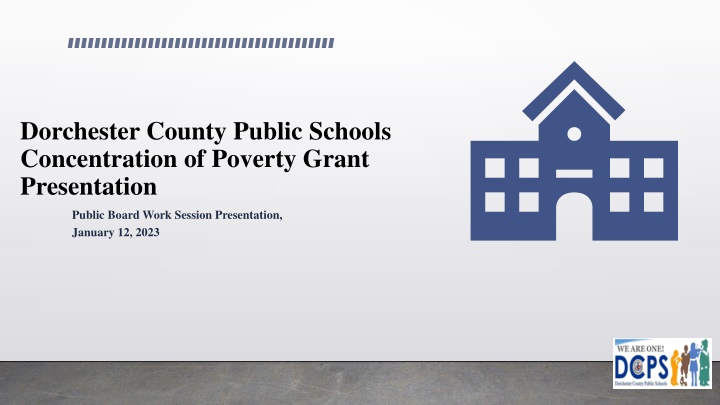
Dorchester County Public Schools Concentration of Poverty Grant Information
Learn about the Concentration of Poverty Grant, its transition to General Fund, historical timeline, FAQs on community schools, eligibility criteria, and fund utilization guidelines. Get insights on school health workers, professional learning opportunities, and needs assessment provided by MSDE.
Download Presentation

Please find below an Image/Link to download the presentation.
The content on the website is provided AS IS for your information and personal use only. It may not be sold, licensed, or shared on other websites without obtaining consent from the author. If you encounter any issues during the download, it is possible that the publisher has removed the file from their server.
You are allowed to download the files provided on this website for personal or commercial use, subject to the condition that they are used lawfully. All files are the property of their respective owners.
The content on the website is provided AS IS for your information and personal use only. It may not be sold, licensed, or shared on other websites without obtaining consent from the author.
E N D
Presentation Transcript
Dorchester County Public Schools Concentration of Poverty Grant Presentation Public Board Work Session Presentation, January 12, 2023
What is the Concentration of Poverty Grant? General Fund? Grant?
1st Year COP funding received Rollover option discontinued Grant funding transitioned to general fund Historical Timeline of COP 2019 2020 2020 2021 2022 2023
Frequently Asked Questions? 1. What is a community school? In 2019, Senate Bill 1030 (5-203) defined community schools as "a public school that establishes a set of strategic partnerships between the school and other community resources that promote student achievement, positive learning conditions, and the well-being of students by providing wraparound services." 2. How do I know if I have community schools in my local school system? Community schools can either be identified by a local school system or through receiving the Concentration of Poverty grant. Schools with 75 percent or more students eligible for free and reduced meals received the Concentration of Poverty grant established in SB 1030 (5-203). The personnel grant is to be used to hire a community school coordinator and professional health care practitioner. Any remaining funding should be used to administer a needs assessment and to provide wraparound services as described in the legislation. DCPS designated schools are : MLMS, CES, HES, MES, and SHES 3. What happens if my local school system cannot spend all of our grant funding by June 30, 2020? This changed- no longer carryover! The expectation is that the grant awards should be fully expended by June 30, 2020. Additionally, local school systems are required to report the use of these funds to the Governor and select committees of the General Assembly. However, the Blueprint for Maryland's Future Fund is a special non-lapsing fund, meaning that unexpended funds at the end of the year do not revert and therefore allow for carryover.
Frequently Asked Questions? 4. Does an LPN qualify as a school health worker under the Concentration of Poverty grant? SB 1030 (5-203) states that eligible schools should provide full-time coverage by at least one professional health care practitioner, who is a "licensed physician, a licensed physician s assistant, or a licensed registered nurse" practicing within the scope of the license. Based on that language, an LPN would not qualify under this specific grant. 5. Can I use Concentration of Poverty funds to provide professional learning to community school coordinators? If the funding provided to an eligible school exceeds the cost to employ a Community School Coordinator and a school health practitioner, excess funding can be used to administer a needs assessment and provide wraparound services. SB 1030 (5-203) provides numerous examples of wraparound services, including "...any professional development for teachers and school staff to quickly identify students in need of these resources. 6. Is MSDE providing a needs assessment to local school systems? At this time, the MSDE is not providing a needs assessment to local school systems. However, the MSDE will provide technical assistance on selecting, administering, and compiling data for the needs assessment. Additionally, the MSDE is working with a work group of community schools' stakeholders to create a model needs assessment that could be used by community schools.
Frequently Asked Questions? 7. What are the reporting requirements for this grant? Will a template be provided by MSDE? At this time, local school systems and schools are not required to report Concentration of Poverty grant budgets, expenditures, or activities to MSDE. Therefore, MSDE will not provide a template for reporting at this time. We report it to the legislature. 8. Will MSDE approve my budget and spending? At this time, the Director of Community Schools at the MSDE is not managing Concentration of Poverty grant funding or reporting. Leaders responsible for the management of the Concentration of Poverty grant should align grant spending with the language on SB 1030 (5-203). Budget documents, including C-l-25s and amendment requests, should be submitted to the Office of Finance. 9. Will MSDE provide support and professional learning for community school coordinators? Yes. The MSDE is committed to providing community school coordinators, school-based leaders, and leaders in local school systems with technical assistance and professional learning on best practices in developing and enhancing community schools. The MSDE is assisting in developing networks of practitioners who can share successes and strong practices throughout the State. Please check the website for more information on upcoming events, including meetings, professional learning opportunities, networking events, and more. Initiated last year, a new contact is currently coordinating on a temporary basis.
How can Concentration of Poverty funds be spent? Senate Bill 1030 (5-203) states that Concentration of Poverty funds must first and foremost be used as a personnel grant for two mandated positions: a community school coordinator and professional health care practitioner. Eligible schools may use any remaining funds to provide wraparound services, which are defined as: I. II. III. Vision and dental services; IV. Establishing or expanding school-based health center services; V. Additional social workers, mentors, counselors, psychologists, and restorative practice coaches; VI. Enhancing physical wellness, including providing healthy food for in-school and out of school time and linkages to community providers; VII. Enhancing behavioral health services, including access to mental health practitioners and providing professional development to school staff to provide trauma-informed interventions; VIII. Providing family and community engagement and supports, including informing parents of academic course offerings, language classes, workforce development training, opportunities for children; and available social services as well as educating families on how to monitor a child's learning; IX. Establishing and enhancing linkages to Judy Centers and other early education programs that feed into the school; X. Enhancing student enrichment experiences; XI. Improving student attendance XII. Improving the learning environment at the school; and XIII. Any other professional development for teachers and school staff to quickly identify students who are in need of these resources. Extended learning time, including before and after school, weekends, Summer school, and an extended school year; Safe transportation to school;
WHAT ARE WE FACING IN THE NEXT AND FUTURE SCHOOL YEARS? - Projected increase in COP funds over of 1 million for SY 23-24, over the $3,685,076 DCPS currently receives. - All requirements remain - Increased legislative oversight
The Blueprints Five Pillars: DCPS s Strategic Plan 1 2 3 4 5 Pillar 1 Early Childhood Education Pillar 2 High Quality and Diverse Teachers and Leaders Pillar 3 College and Career Readiness Pillar 4 More Resources for Students Who Need Them Pillar 5 Governance and Accountability
State & Local Funding Projections Declining enrollment could mean a reduction in County maintenance of effort Blueprint salary initiatives could cost $12,600,000 over next 4 years Local Share of Blueprint initiatives could mean higher County funding ($3,500,000 for FY24) Blueprint funding formulas could mean more State funding, but, with very specific uses Declining enrollment could offset increases in State formula funding



